“At the seaside all is narrow horizontals, the world reduced to a few long straight lines pressed between earth and sky.”
-John Banville
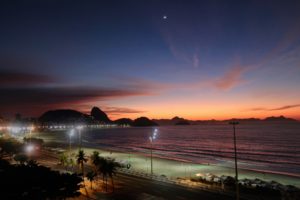 Wake up and step into the sound of the ocean.
Wake up and step into the sound of the ocean.
My body is a crumpled piece of paper that will only be smoothed by some elusive and external force that I can’t yet access. It’s the twelve-hour flights. Age forty and up would appear to be a terrible moment to make these types of endeavor the norm—but it’s the resulting payoff that always manages to shelve the resultant aches. In this instance, the feeling shrinks once I catch my first glimpse of what this corporeal tax has also served me.
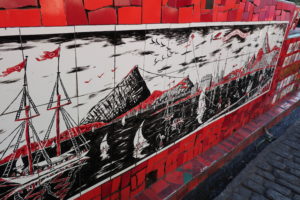 It’s not even sunrise, but that moment is coming. I feel this as I wander out of my appointed bedroom and follow the noise. I hear the sound of an especially forceful ocean that makes me wonder how Cabral and his ilk demonstrated near-godlike tolerance for discomfort as they took to sea some 500 years ago. The intestinal fortitude and delusion it must have taken to sail into the unknown, 4,000 nautical miles from Portugal, and lay stake in a land of indigenous people to change the course of history. My twelve-hour flight across a great circle route? Please. That was the 15thcentury version of cake.
It’s not even sunrise, but that moment is coming. I feel this as I wander out of my appointed bedroom and follow the noise. I hear the sound of an especially forceful ocean that makes me wonder how Cabral and his ilk demonstrated near-godlike tolerance for discomfort as they took to sea some 500 years ago. The intestinal fortitude and delusion it must have taken to sail into the unknown, 4,000 nautical miles from Portugal, and lay stake in a land of indigenous people to change the course of history. My twelve-hour flight across a great circle route? Please. That was the 15thcentury version of cake.
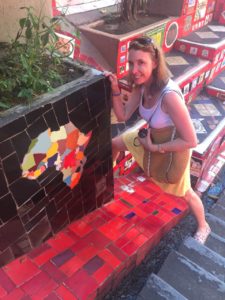 But I’m a creature of the modern day, and it is now the sunrise that has my undivided attention. The first moments of my predawn reveille were confusing. Like so many times in the past, I found myself standing up before I knew it, eyes searching a pitch-dark room with no real sense of direction or comprehension. Where am I? A solid minute felt to pass before I could access some mental mapping of the apartment under my feet. This used to happen all the time when I was living in Dakar: my chronic confusion the product of too much travel with departures and arrivals in the middle of the night that left my own home feeling alien à la I need to use the bathroom, but I have no idea where it is located.
But I’m a creature of the modern day, and it is now the sunrise that has my undivided attention. The first moments of my predawn reveille were confusing. Like so many times in the past, I found myself standing up before I knew it, eyes searching a pitch-dark room with no real sense of direction or comprehension. Where am I? A solid minute felt to pass before I could access some mental mapping of the apartment under my feet. This used to happen all the time when I was living in Dakar: my chronic confusion the product of too much travel with departures and arrivals in the middle of the night that left my own home feeling alien à la I need to use the bathroom, but I have no idea where it is located.
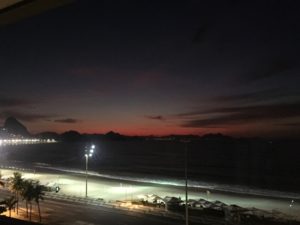 But as soon as I opened this bedroom door, it was the sound that told me to where I needed to go. The apartment has an expansive but spartanly furnished common area, complete with wall to wall windows that face the Atlantic Ocean. My jet-lagged brain says that it should be noon, but the world in Rio de Janeiro tells me differently. The beach down below is empty, save for a few solitary sticks with Brazilian flags flapping sturdily in a wind that brings the incoming waves toward me with a strange ferocity. Explorers once sailed here in carracks. They battled these elements in order to record what I was now experiencing with my gringo eyes.
But as soon as I opened this bedroom door, it was the sound that told me to where I needed to go. The apartment has an expansive but spartanly furnished common area, complete with wall to wall windows that face the Atlantic Ocean. My jet-lagged brain says that it should be noon, but the world in Rio de Janeiro tells me differently. The beach down below is empty, save for a few solitary sticks with Brazilian flags flapping sturdily in a wind that brings the incoming waves toward me with a strange ferocity. Explorers once sailed here in carracks. They battled these elements in order to record what I was now experiencing with my gringo eyes.
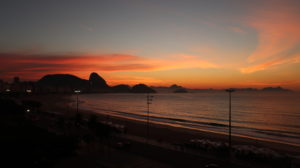 The dim orange on the horizon is starting to reach upward with an uneven gradient effect. Maybe it’s due to the low and bumpy presence of Pão de Açúcar and coupled with the clouds that play nearby. Whatever the case, there’s the light, it also acts as a highlighter waving across the incoming waves as the water skinnies out and stretches onto the smooth praia. The crashing waves in early dawn are an unnatural lime green. I take photo after photo of the light as it changes, even if the difference is ultimately imperceptible. No one would believe that I am witnessing such a symphony of color, especially when I review each photographic capture and think, “But no—it looks even better than this!”
The dim orange on the horizon is starting to reach upward with an uneven gradient effect. Maybe it’s due to the low and bumpy presence of Pão de Açúcar and coupled with the clouds that play nearby. Whatever the case, there’s the light, it also acts as a highlighter waving across the incoming waves as the water skinnies out and stretches onto the smooth praia. The crashing waves in early dawn are an unnatural lime green. I take photo after photo of the light as it changes, even if the difference is ultimately imperceptible. No one would believe that I am witnessing such a symphony of color, especially when I review each photographic capture and think, “But no—it looks even better than this!”
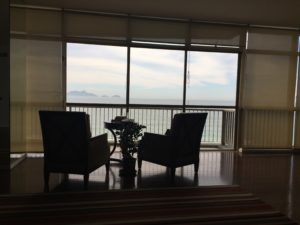 My friends, the ones hosting me in this apartment, I first met them during those days of Dakar disorientation. They clearly understood the significance of what was taking place in front of their home each day. In the centerline of their living room, they placed two chairs that were angled to each other, but ultimately faced to the eastern horizon. In essence, their home became widescreen viewing for the three-dimensional sea.
My friends, the ones hosting me in this apartment, I first met them during those days of Dakar disorientation. They clearly understood the significance of what was taking place in front of their home each day. In the centerline of their living room, they placed two chairs that were angled to each other, but ultimately faced to the eastern horizon. In essence, their home became widescreen viewing for the three-dimensional sea.
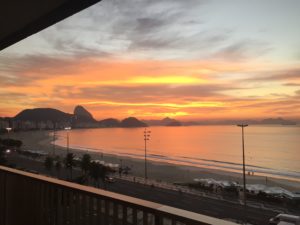 It is not long before one of the house’s inhabitants them stirs. He walks up quietly and offers me a cup of black coffee. Then he takes the empty chair next to mine and commences with what is clearly a well-established silent morning routine. This is when I realized what they had. They get it, and they are wonderfully aware of their good fortune. Like moths to flame, they have understood that this should and will be the standard activity for as long as they exist here. You sit, stare out to sea, and wonder if the rest of the world is getting anything close to this.
It is not long before one of the house’s inhabitants them stirs. He walks up quietly and offers me a cup of black coffee. Then he takes the empty chair next to mine and commences with what is clearly a well-established silent morning routine. This is when I realized what they had. They get it, and they are wonderfully aware of their good fortune. Like moths to flame, they have understood that this should and will be the standard activity for as long as they exist here. You sit, stare out to sea, and wonder if the rest of the world is getting anything close to this.
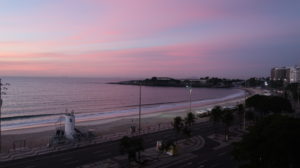 And of course, the answer is yes. You don’t need to fly or sail yourself anywhere exotic in order to lay witness to the colors of the sun as it loiters near the horizon. But there are some places to experience that make it all the more special. As for me, I’ve never piloted a 15th-century sailing ship, but I have stood my share of early morning bridge watches from 0200 to 0700. It was often my favorite time of day: the bridge was settled, the captain was asleep, and our small collection of watchstanders knew to give the sunrise its due respect. We’d go about our standard routines while keeping an eye on the horizon—recording the shifting colors with silent, low-grade awe.
And of course, the answer is yes. You don’t need to fly or sail yourself anywhere exotic in order to lay witness to the colors of the sun as it loiters near the horizon. But there are some places to experience that make it all the more special. As for me, I’ve never piloted a 15th-century sailing ship, but I have stood my share of early morning bridge watches from 0200 to 0700. It was often my favorite time of day: the bridge was settled, the captain was asleep, and our small collection of watchstanders knew to give the sunrise its due respect. We’d go about our standard routines while keeping an eye on the horizon—recording the shifting colors with silent, low-grade awe.
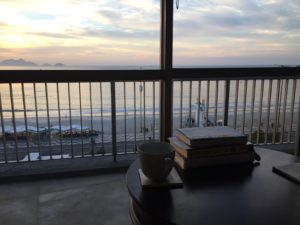 I don’t think much about the fatigue now as I sip my coffee and now feel settled in this living room chair. The rest of the house starts to stir. My other friend emerges from her room and looks at me with understanding. It’s amazing, isn’t it? The five-year-old, she soon will emerge too, and she’ll climb into my lap and have no clue at how lucky she is to start life with this sort of experience. As for me, the confusion that came with jet lag dissipates and my body’s crumpling is starting to work itself out. It’s that thing about the sea, the medicinal effect that is something close to magic. And for now, I’ll sit here awhile longer. And see how the rest of this life will unfold.
I don’t think much about the fatigue now as I sip my coffee and now feel settled in this living room chair. The rest of the house starts to stir. My other friend emerges from her room and looks at me with understanding. It’s amazing, isn’t it? The five-year-old, she soon will emerge too, and she’ll climb into my lap and have no clue at how lucky she is to start life with this sort of experience. As for me, the confusion that came with jet lag dissipates and my body’s crumpling is starting to work itself out. It’s that thing about the sea, the medicinal effect that is something close to magic. And for now, I’ll sit here awhile longer. And see how the rest of this life will unfold.